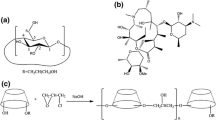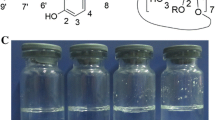Abstract
Lycopene, the aliphatic hydrocarbon carotenoid with abundant bioactivities, has instability, extremely poor water solubility, and low oral bioavailability. The study aimed to develop a highly water-soluble and practical lycopene formulation to improve the oral bioavailability and efficiency of lycopene. Environment-friendly hot-melt extrusion (HME) technique was applied to fabricate lycopene-cyclodextrin-polyethylene glycol 6000 (PEG 6000) ternary systems, which possessed highly aqueous solubility (897.665 μg mL−1), almost 32-fold higher than that of the reported lycopene binary inclusion (27.1 ± 3.2 μg mL−1). The dissolution rate was significantly accelerated compared to pure lycopene. The molecular mechanism was further investigated by the integrated experimental and modeling tools. Molecular dynamics (MD) simulation revealed lycopene molecule was wrapped within the aggregates of hydroxypropyl-beta-cyclodextrin (HP-β-CD) and PEG 6000 through extensive hydrogen bond interactions, which was experimentally validated by DSC, XRD, and FTIR spectrum analysis. The third component PEG 6000 facilitated the process of HME and augmented hydrogen bond interactions with HP-β-CD. Moreover, lycopene inclusions exhibited significant antitumor activity via inhibiting cell proliferation and inducing apoptosis. The pharmacokinetic studies showed the relative bioavailability of lycopene ternary preparation was up to 313.08% and the Cmax was 4.9-fold higher than that of the marketed tablet. In conclusion, the lycopene cyclodextrin ternary formulation developed by the modified HME techniques is suitable for industrial production, while PEG 6000 plays a vital part in the multicomponent systems to increase solubility, dissolution rate, and oral bioavailability of lycopene. The combination of experimental and computational tools is able to benefit the development of multicomponent formulations accurately and effectively.





Similar content being viewed by others
References
Jiang Y, Wang X, Dong S, Li Y, Yu C. Application and study of lycopene. Chin J Dis Control Prev. 2008;12(1):66–9.
Al-Eisa RA. Synergistic antioxidant capacity of chitosan nanoparticles and lycopene against aging hepatotoxicity induced by D-galactose in male rats. Int J Pharm. 2018;14(6):811–25.
Müller L, Caris-Veyrat C, Lowe G, Böhm V. Lycopene and its antioxidant role in the prevention of cardiovascular diseases-a critical review. Crit Rev Food Sci. 2016;56(11):1868–79.
Böhm V. Lycopene and heart health. Mol Nutr Food Res. 2012;56(2):296–303.
Chen DJ, Huang C, Chen Z. A review for the pharmacological effect of lycopene in central nervous system disorders. Biomed Pharmacother. 2019;111:791–801.
Mapelli-Brahmb P, Margiera M, Desmarcheliera C, Halimia C, Nowickia M, Borela P, et al. Comparison of the bioavailability and intestinal absorption sites of phytoene, phytofluene, lycopene and β-carotene. Food Chem. 2019;300:1–6.
Melendez-Martinez AJ, Mapelli-Brahm P, Benitez-Gonzalez A, Stinco CM. A comprehensive review on the colorless carotenoids phytoene and phytofluene. Arch Biochem Biophys. 2015;572:188–200.
Van Breemen RB, Pajkovic N. Multitargeted therapy of cancer by lycopene. Cancer Lett. 2008;269(2):339–51.
Rochaa GA, Favaro-Trindade CS, Grosso CRF. Microencapsulation of lycopene by spray drying: characterization, stability and application of microcapsules. Food Bioprod Process. 2012;90(1):37–42.
Zhu J, Hu Q, Shen S. Enhanced antitumor efficacy and attenuated cardiotoxicity of doxorubicin in combination with lycopene liposomes. J Liposome Res. 2019;10:1–8.
Salimi A, Maghsoudlou Y, Jafari SM, Sadeghi MA, Kashaninejad M, Ziaiifar AM. Preparation of lycopene emulsions by whey protein concentrate and maltodextrin and optimization by response surface methodology. J Disper Sci Technol. 2015;36:274–83.
Vertzoni M, Kartezini T, Reppas C, Archontaki H, Valsami G. Solubilization and quantification of lycopene in aqueous media in the form of cyclodextrin binary systems. Int J Pharm. 2005;309(1):115–22.
Faisala W, Ruane-O’Horab T, O’Driscolla CM, Griffina GM. A novel lipid-based solid dispersion for enhancing oral bioavailability yof lycopene-in vivo evaluation using a pig model. Int J Pharm. 2013;453(2):307–14.
Kurkov SV, Loftsson T. Cyclodextrins. Int J Pharm. 2013;453(1):167–80.
Sherje AP, Kulkarni V, Murahari M, Nayak UY, Bhat P, Suvarna V, et al. Inclusion complexation of etodolac with hydroxypropyl-beta-cyclodextrin and auxiliary agents: formulation characterization and molecular modeling studies. Mol Pharm. 2017;14(4):1231–42.
Ashour EA, Majumdar S, Alsheteli A, Alshehri S, Alsulays B, Feng X, et al. Hot melt extrusion as an approach to improve solubility, permeability and oral absorption of a psychoactive natural product, piperine. J Pharm Pharmacol. 2016;68(8):989–98.
Wang J, Wolf RM, Caldwell JW, Kollman PA, Case DA. Development and testing of a general amber force field. J Comput Chem. 2004;25(9):1157–74.
Valverde J. Molecular modelling: principles and applications. Brief Bioinform. 2001;2(2):199–200.
Zhao Q, Miriyala N, Su Y, Chen W, Gao X, Shao L, et al. Computer-aided formulation design for a highly soluble lutein-cyclodextrin multiple-component delivery system. Mol Pharm. 2018;15(4):1664–73.
Chen W, Ouyang D. Investigation of molecular dissolution mechanism of ketoprofen binary and ternary solid dispersions by molecular dynamics simulations. Mol Simulat. 2017;43(13–16):1074–80.
Huang T, Zhao Q, Su Y, Ouyang D. Investigation of molecular aggregation mechanism of glipizide/cyclodextrin complexation by combined experimental and molecular modeling approaches. Asian J Pharm Sci. 2019;14(6):609–20.
Ouyang D. Investigating the molecular structures of solid dispersions by the simulated annealing method. Chem Phys Lett. 2012;554:177–84.
Zeng Z, Shen ZL, Zhai S, Xu JL, Liang H, Qin S, et al. Transport of curcumin derivatives in Caco-2 cell monolayers. Eur J Pharm Biopharm. 2017;117:123–31.
Li W, Yalcin M, Lin Q, Ardawi MSM, Mousa SA. Self-assembly of green tea catechin derivatives in nanoparticles for oral lycopene delivery. J Control Release. 2017;248:117–24.
Wang R, Zhou H, Siu SWI, Gan Y, Wang Y, Ouyang D. Comparison of three molecular simulation approaches for cyclodextrin-ibuprofen complexation. J Nanomater. 2015;16(1):267.
Khor CM, Ng WK, Kanaujia P, Chan KP, Dong YC. Hot-melt extrusion microencapsulation of quercetin for taste-masking. J Microencapsul. 2017;34(1):29–37.
Silva LAD, Almeida SL, Alonso ECP. Preparation of a solid self-microemulsifying drug delivery system by hotmelt extrusion. Int J Pharm. 2018;541(1–2):1–10.
Yoonseon J, Weon LJ, Hyeyoung K. Lycopene inhibits reactive oxygen species-mediated NF-κB signaling and induces apoptosis in pancreatic cancer cells. Nutrients. 2019;11(4):762.
Duque MD, Issa MG, Silva DA, Kakuda BAS, Rodrigues LNC, Lobenberg R, et al. Intrinsic dissolution simulation of highly and poorly soluble drugs for BCS solubility classification. Dissolut Technol. 2017;24(4):6–11.
Ma Y, Li PB, Chen DW, Fang TZ, Li HT, Su WW. LC/MS/MS quantitation assay for pharmacokinetics of naringenin and double peaks phenomenon in rats plasma. Int J Pharm. 2006;307(2):292–9.
Funding
The Science and Technology Program of Guangzhou, China (Grant numbers 201604020166 and 201904010110) supported this study.
Author information
Authors and Affiliations
Corresponding authors
Ethics declarations
Conflict of Interest
The authors declare that they have no conflicts of interest.
Additional information
Publisher’s Note
Springer Nature remains neutral with regard to jurisdictional claims in published maps and institutional affiliations.
Yan Ma, Liuting Zhong, and Zhuo Peng share first authorship of this article
Supplementary Information
ESM 1
(DOCX 171 kb)
Rights and permissions
About this article
Cite this article
Ma, Y., Zhong, L., Peng, Z. et al. Development of a Highly Water-Soluble Lycopene Cyclodextrin Ternary Formulation by the Integrated Experimental and Modeling Techniques. AAPS PharmSciTech 22, 5 (2021). https://doi.org/10.1208/s12249-020-01861-3
Received:
Accepted:
Published:
DOI: https://doi.org/10.1208/s12249-020-01861-3




